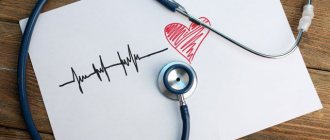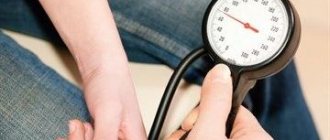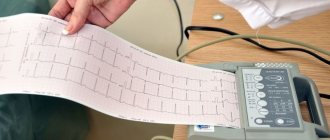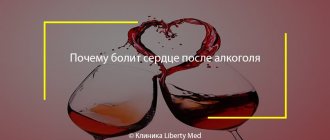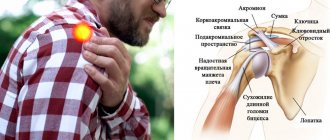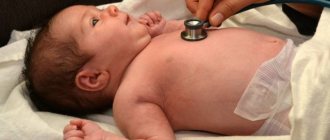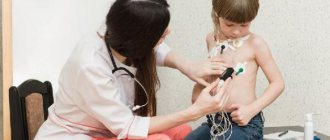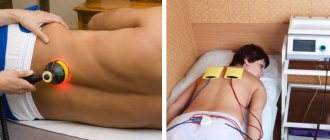- Causes
- Pathologies
- Diagnostics
- Treatment
- Our doctors
If your heart is beating fast, it is normal to feel it. In cases where the condition is caused by physiological factors, the state of health returns to normal on its own, without visiting a doctor.
Every person has experienced heart palpitations at one time or another. This condition can be either normal or pathological. Only a doctor can determine the exact cause after an examination, but you can independently determine whether you should rush to a specialist or not to worry.
How does your heart work?
The heart is a unique muscular organ located in the middle of the chest. The heart pumps blood throughout the body, saturating cells with oxygen and nutrients. The muscular septum divides the heart longitudinally into left and right halves. The valves divide each half into two chambers: the upper (atrium) and the lower (ventricle).
As the heart muscle contracts, it pushes blood first through the atria and then through the ventricles. In the lungs, the blood is saturated with oxygen and through the pulmonary veins enters the left atrium, then into the left ventricle and from it, through the aorta and arterial vessels branching from it, it is distributed throughout the body.
Having given up oxygen, the blood collects in the vena cava, and through them into the right atrium and right ventricle. From there, through the pulmonary artery, the blood enters the lungs, where it is again enriched with oxygen. The main indicator of the heart's performance is the amount of blood it must pump in 1 minute. Usually for an adult this is at least 5.0 liters (300 liters per hour, 7200 liters per day).
The heart beats more than 100,000 times a day, pumping blood through the 20,000 km of veins and arteries that make up the human circulatory system.
When an adult is at rest, the heart beats 60 to 80 times per minute. During physical activity, at a time of stress or excitement, the heart rate can increase to 200 beats per minute.
What to do if your heart beat is higher than normal? First aid
If such an attack occurs for the first time or very rarely and the person does not have any heart diseases or pathologies, then a number of measures can be taken to stop the heart pounding:
- Open the window and let fresh air flow into the room;
- Free your neck - unbutton the collar of your clothing;
- Wash your face and neck with cold water;
- Take a horizontal position to relax;
- Use medications to stop the attack.
How to calm your heartbeat?
To quickly relieve symptoms of heartbeat, use Valerian tincture: 20 drops of tincture per 50 ml of water. Valerian will help not only lower the heart rate, but also calm the nerves, especially when an attack occurs at night and a person panics.
If your heart sometimes starts beating?
You can simply cough and the attack of tachycardia will pass.
Eye massage helps relieve heart palpitations
The massage must be done for at least 5 - 7 minutes:
- Press the phalanges of your fingers on your closed eyes;
- Apply compression for 10 - 15 seconds;
- Pause between pressure techniques 10 - 15 seconds;
- You need to repeat until the attack goes away.
Heart rhythm and conduction disorders
The normal heart rhythm is called sinus rhythm.
The heart has its own electrical (conducting) system, consisting of an electrical impulse generator - the main pacemaker - and conductive pathways connecting the entire electrical circuit. The main pacemaker, located in the right atrium, generates regular electrical impulses at a certain frequency, like a metronome. In response to each impulse, the chambers of the heart contract in strict sequence.
First, a wave of electrical excitation covers the atria, as a result of which they simultaneously contract, throwing blood into the ventricles. Having passed through the atria, the wave does not immediately pass to the ventricles, since they are separated from the atria by tissue that is unable to conduct electrical impulses. In only one small area, a single “bundle of wires” passes through this tissue, through which, after a short delay, the electrical impulse can travel to the ventricles and cause the same wave-like contraction as in the atria. This bundle is called the atrioventricular junction (AV node), and the delay between the contraction of the atria and ventricles is necessary so that the atria have time to “push” blood into the ventricles before the latter begin to contract.
Normally, the atrioventricular junction is the only place in the heart where the transfer of electrical excitation to the ventricles occurs. After this, the electrical impulse spreads through both ventricles, causing them to contract. At the same time, the blood is pushed out of them into the arteries, providing blood supply to all organs of the body and the heart itself.
Thus, a normal heart rhythm differs from an abnormal one in two main features: regularity and a certain frequency. Any disturbance in heart rhythm is always a consequence of dysfunction of the conduction system.
Bradycardia. Slow heart rate
Your heart rate usually beats between 60 and 80 beats per minute.
A reading below 60 beats per minute is called bradycardia. For many people in good physical shape, or if such a rhythm occurs during rest and sleep, then such a rhythm is normal. A distinctive feature of such bradycardia is that with increasing physical activity, the heart rate begins to accelerate, covering the body’s needs with its frequency.
We talk about bradycardia as a disease when the rhythm has a very low frequency, does not respond by increasing frequency to physical activity, or large pauses occur in the rhythmic contraction, which can reach or even exceed more than 2 seconds. Such disturbances lead to fatigue, dizziness and loss of consciousness.
The most common cause of a slow heart rate is:
• Sinus node dysfunction (SU).
• Impaired conduction of the electrical signal from the atria to the ventricles through the atrioventricular node (AV).
When bradycardia is confirmed diagnostically and such a rhythm is the only manifestation, then such a rhythm is effectively corrected by a pacemaker. ICDs can also be used for bradycardia, but only if there are appropriate indications for ICD implantation (life-threatening cardiac arrhythmias).
Treatment
It is a common situation when cardiac pathology is the basis of the nightly “pranks” of the pulse. In this case, treatment aimed at getting rid of cardiac pathology will help. The main goal of therapy is to reduce the number of attacks and their severity. Indeed, in the presence of myocardial pathology, a violation of the rhythm of contractions gradually turns into a factor aggravating heart disease.
When the cause of night attacks is high blood pressure, the doctor prescribes antihypertensive drugs and determines the dose individual for the patient. As a rule, the evening dosage of the medication is increased. If the issue is sleep apnea, then everything is more complicated. Therapeutic measures in relation to it have a weak effect.
In all cases, doctors advise sleeping on your side. But sleeping people usually do not control the position of their own body in their sleep. For this reason, the only effective method is the use of special devices for ventilation. Such gadgets pressurize oxygen through a mask into the lungs of those sleeping.
To prevent your tongue from closing your windpipe at night, you can lose excess weight and cure ENT pathology. One hundred percent option: the doctor selects a gadget that fixes the position of the lower jaw while you sleep. Straining, changing body position, and taking a hot-cold shower will help quickly (but not for long) make tachycardia disappear.
Psychotherapy
The trigger for an increase in heart rate at night can be a mental injury, after which the patient wakes up for a long time, attacked by panic attacks. A qualified psychotherapist will help eliminate this problem. Beta-blockers and sedatives are indicated as medications.
General recommendations for nocturnal tachycardia - normalize sleep, increase the overall tone of the body
Tachycardia
If your heart rate exceeds 100 beats per minute, it is called tachycardia. Tachycardia can be sinus and belong to normal, physiological tachycardia. Tachycardias with a high frequency, which exceed 180 beats per minute, arising in connection with frequent, group extrasystole, additional conduction pathways are classified as a group of non-normal fast heart rhythms.
Physical activity, emotional stress, and certain diseases can cause an accelerated heart rate that exceeds 100 beats per minute.
When your heart rhythm is very fast or your heart beats for no reason at a high frequency and irregularly, it is called tachyarrhythmia.
Pathological tachycardia is harmful for several reasons. Firstly, with a rapid heartbeat, the efficiency of the heart decreases, since the ventricles do not have time to fill with blood, as a result of which blood pressure drops and blood flow to the organs decreases. Secondly, the conditions of the blood supply to the heart itself worsen, since it does more work per unit of time and requires more oxygen, and poor conditions of the blood supply to the heart increase the risk of coronary disease and subsequent heart attack.
Tachycardia is not a disease, but a symptom, since it can occur as a manifestation of many different diseases. The most common causes of tachycardia are disorders of the autonomic nervous system, endocrine system disorders, hemodynamic disorders and various forms of arrhythmia.
Rapid heartbeat with normal blood pressure
However, increased heartbeat can be felt regardless of blood pressure. The pressure may be low or normal, but the patient complains of palpitations. This is possible with vegetative-vascular dystonia, anemia, thyroid diseases and a number of other diseases. You should not try to determine what you are sick with, much less begin treatment only on the basis of comparing your heartbeat and blood pressure. In all cases when you are concerned about increased heart rate, you must undergo an examination as prescribed by your doctor.
Tachyarrhythmia
This is an abnormally fast heart rate (usually 100 to 400 beats per minute, which occurs either in the upper chambers of the heart (atrial fibrillation, supraventricular tachycardia) or in the lower chambers (ventricular fibrillation, ventricular tachycardia)).
Causes of tachyarrhythmia:
• Heart diseases such as high blood pressure, coronary artery disease (atherosclerosis), heart valve disease, heart failure, cardiomyopathy, tumors and infections.
• Other medical conditions, such as thyroid disease, some lung diseases, electrolyte imbalances, and alcohol and drug abuse.
• Caused by abnormal accessory pathways or extrasystoles.
Tachyarrhythmias occur when the impulse contracting the heart muscle arrives earlier than normal heart rhythm would suggest. Tachyarrhythmias can begin in the upper or lower chambers of the heart.
Tachyarrhythmia includes various types of cardiac arrhythmias:
• Supraventricular tachycardia.
• Ventricular tachycardia (VT).
• Ventricular fibrillation (VF).
Diagnostics
If you have increased heartbeat, you should consult a therapist. He will refer you for an examination, with the results of which the patient will go to a specialist: a cardiologist, endocrinologist or neurologist. The list of diagnostic measures if the heart is beating strongly includes:
- general blood analysis;
- ECG;
- blood test for thyroid hormones;
- Ultrasound of the heart (EchoCG);
- daily monitoring of pulse and heart activity according to Holter;
- Ultrasound of the thyroid gland.
If the disease cannot be detected by laboratory and instrumental methods, a consultation with a psychiatrist may be required.
Read also: Heartache
Supraventricular tachyarrhythmias
Rhythm disorders involving the atria are called supraventricular (supraventricular) arrhythmias. This group of rhythm disturbances is the most common, and it is the one that doctors and patients have to deal with most often. There are 5 main types of supraventricular arrhythmias:
• atrioventricular nodal tachycardia;
• Wolff-Parkinson-White syndrome;
• intraatrial tachycardia;
• atrial flutter;
• atrial fibrillation.
What does an increased heart rate mean when you wake up in the morning?
With cardiac pathologies, a paroxysmal type of tachycardia may develop, which is accompanied by severe headache, dizziness and nausea. With a severe attack of rapid heartbeat, chest pain, convulsions and fainting may occur.
Treatment of strong heartbeat
Treatment of high heart rate begins with diagnosis and identification of the causes of tachycardia. And the cardiologist, based on a diagnostic examination, prescribes a course of drug therapy. It is very important to eliminate the cause of the disease and relieve the patient of the symptoms that tachycardia causes: an attack of nausea, headaches, an attack of shortness of breath and fainting.
A diagnostic examination should be carried out not only by a cardiologist, but also by consultation with such specialists: an endocrinologist, a neurologist and a psychotherapist.
Two methods are used for treatment: therapy with medications and therapy with drugs based on medicinal plants and medicinal herbs.
| group of drugs | Name | dosage | course of therapy |
| cardiac glycosides | Digoxin | maximum daily dosage 1.5 mg, divided into 2 - 3 doses | course of treatment up to 7 calendar days |
| beta blockers | Atenolol | maximum dosage for an adult patient - 200 mg per day | the course of therapy is individual and established by a cardiologist |
| sedatives | Sedasen | 1 tablet, 2 times a day or 2 tablets once a day | admission course 14 calendar days |
| antioxidants | Preductal | 35 mg of the drug 2 times a day with meals | admission course up to 90 calendar days |
Atrial fibrillation (AF)
Atrial fibrillation is the most common arrhythmia, usually a manifestation of other heart diseases (coronary heart disease, valvular disease, myocarditis, etc.) or metabolic disorders (thyrotoxicosis, electrolyte imbalance, etc.). Sometimes it occurs without an obvious cause, and then it is called idiopathic.
The mechanisms of development of atrial fibrillation are still not fully understood. In some patients, it occurs due to the presence of many chaotic circular waves of electrical excitation in the atria.
Atrial fibrillation is usually treated with medications that maintain a normal rhythm or prevent the heart rate from getting too fast. A prerequisite for atrial fibrillation is the use of anticoagulant therapy. It is used to thin the blood to prevent the formation of blood clots.
For the surgical treatment of atrial fibrillation, the method of radiofrequency ablation (RFA) is used, which is used to slow down the heart rate (RFA of the AV junction) or RFA “isolation of the pulmonary veins” is performed to restore sinus rhythm.
Floating and meditation can help you learn interoception
Interoception also explains the effectiveness of certain practices. There is evidence that floating helps with anxiety and depression, with even one hour of this procedure providing short-term positive effects. Perhaps the reason is that during floating, exteroception is temporarily turned off and attention is focused on internal sensations.
Mindfulness and other types of meditation also force you to concentrate on your body. However, the disadvantage of meditation is that it does not help you become more aware of your body. Garfinkel believes that training and measuring interoception can make meditation practice more effective.
Ventricular tachycardia (VT)
VT refers to an abnormally rapid heartbeat. The source of such a rhythm may be an ectopic focus in the myocardium of the right or left ventricle. Typically, the cause of ventricular abnormal pacemakers is diseases of the heart muscle (coronary heart disease, arrhythmogenic dysplasia of the right ventricle, etc.). In VT, the heart does not pump blood as efficiently as it does in normal sinus rhythm. The rapid rhythm of contractions prevents the ventricles from filling completely between individual heartbeats. As a result, the volume of blood circulation in the body decreases.
With VT, symptoms such as dizziness, fainting, presyncope, and loss of consciousness occur. For most patients, VT is considered a very dangerous rhythm, which can lead to the death of the patient.
Signs and warning signs
Conditions when you need to pay attention to your health and immediately consult a doctor:
- the appearance of shortness of breath (I can’t breathe);
- noise in the ears, cranium;
- dizzy;
- it becomes dark in the eyes;
- there is weakness up to loss of consciousness;
- heartache.
You must immediately call an ambulance, and while waiting for it you must:
- free the patient’s neck and chest from tight clothing;
- provide air access to the patient (open the window);
- apply cold to your forehead, rinse your face with very cold water.
Ventricular fibrillation (VF)
VF is a very fast, irregular heart rhythm that occurs in the right or left ventricle of the heart. VF is a more serious pathology than VT because the electrical system of the heart and the heartbeat cycle are completely disorganized. The ventricles tremble and the body receives only a small amount of pumped blood or none at all.
When the heart does not pump blood, the body quickly begins to experience oxygen starvation and sudden cardiac arrest occurs.
Symptoms develop immediately: first the pulse disappears, then consciousness, then the ability to breathe. If sudden cardiac arrest occurs, cardiopulmonary resuscitation (CPR) is required to keep the blood circulating until an external defibrillator can be used to restore the heart rhythm. Defibrillation can be performed by a doctor or emergency medical personnel using an external defibrillator by discharging an electric current through plates located on the chest. If the patient has an ICD implanted, defibrillation will occur automatically after a few seconds of VF onset.
Symptoms
The complaints of people who have suffered such an attack are similar to one another: “I sleep terribly, I suddenly wake up at night from a strong heartbeat, I can’t breathe normally, I can’t sleep, I break out in a cold sweat.” The essence of the complaints is disturbance of night sleep and a feeling of a racing pulse.
Frequent interruption of night rest, when the heart beats strongly, leads to the fact that a person gets up after sleep without a feeling of freshness, broken, and unable to concentrate during the day. Insomnia often occurs.
The somatic side of the attacks - increased heart rate - is combined with the psychological - panic attacks. They frighten a person, but since they occur at night during sleep, they take the form of disturbing or nightmare dreams. Having awakened, a person does not regard dreams, even terrible ones, as a reason for concern about health.
You can do nothing if sleep is disturbed by attacks of tachycardia only occasionally. When your heart beats at a frantic rhythm from night to night, you cannot remain careless: you cannot do without the help of a competent doctor. Ignoring the problem of a strong heartbeat is fraught with aggravation of attacks.
The following signs indicate a deterioration of the situation and the transition of night palpitations to a more severe form:
- the appearance of chest compression;
- heartache;
- feeling dizzy
- loss of consciousness.
These symptoms join existing night attacks and signal the need to see a doctor as soon as possible.
